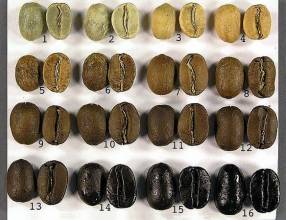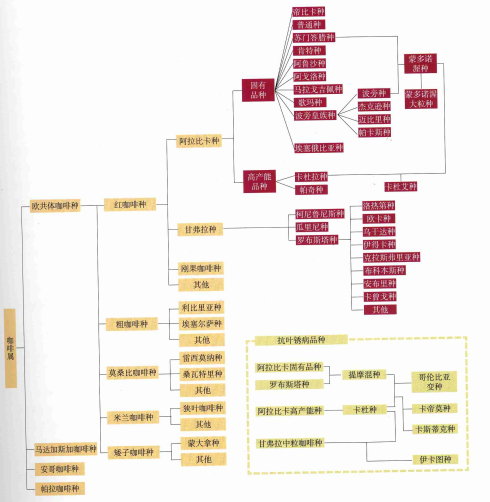Coffee roasting curve is very different. Detailed operation of coffee baking curve introduces different colors of coffee.

From turning on the heat engine, after putting in the raw coffee beans, watch the temperature of the roaster rise until the return point, wait for the first explosion, or wait for the second explosion to complete the baking. Roasting coffee may seem simple, but it is actually an art that requires experience.
Generally speaking, experienced bakers will have an in-depth understanding of the original taste and characteristics of raw beans. From the area where coffee is grown, climate, altitude, and the way coffee fruits are processed after harvest, to the water content of coffee beans during packaging, and the temperature and humidity stored at the export of coffee beans, all affect the taste of coffee baked. Understanding the impact of these elements on roasting is exactly the roasting skills pursued by coffee experts.
Many experienced coffee roasting companies should have no big problems with buying, roasting, selling, and inventory management of coffee beans. However, for many novice roasters, they don't know how to choose the quantity they need to buy, or how long it will take to sell the coffee. Even experienced coffee roasting companies sometimes encounter too much coffee in stock to be sold within a certain period of time, leaving bags of raw coffee beans that have been kept for a long time and do not know what to do with them.
Boutique coffee is a luxury in coffee. Sometimes due to changes in seasons and weather, improper preservation in the harvest process will affect the quality of raw coffee beans and accelerate the aging of raw coffee beans. So whatever the reason, large coffee roasters or their own roasters must know how to tailor a unique baking curve to determine the best flavor and flavor spectrum of coffee.
In the coffee roasting world, the baking curve is a technical term for recording changes in the roasting process, understanding the water content of raw coffee beans, and carefully measuring the weight before and after baking. In addition to recording the production area and baking capacity, the weightlessness ratio should also be recorded after waiting for the baking to be completed. Adjust and record the dehydration status of coffee roasting in detail, how to use a few percent of the capacity of coffee roasting boiler, how to adjust the hot air exhaust throttle, whether coffee can be roasted by the original curve, and what is the temperature recovery point of coffee.
When paying attention to the process of coffee change, the baker can use the above factors to judge and design the baking curve. To put it simply: when the raw beans go directly into the roaster, how long will it take to warm up before the curve on the thermometer begins to climb up with a smile. When the coffee beans are dehydrated and turn orange, how long does it take to produce the first explosion, to reach the ideal roasting degree, or to reach the roasting degree of the second explosion? The roaster needs to take how many baking samples to judge the time of the coffee.
No matter the new bean or the old bean, all have its unique baking curve, so we must accurately judge the bean and the time of the bean, and master the best flavor. In the process of recording the baking curve, carefully blindly test each batch of baked beans, record them, and accurately grasp the key elements, you will be able to grasp the taste of coffee beans. Remember that each batch of coffee beans has a different baking curve and roasting methods. The environmental factors of raw coffee beans in the producing areas will also affect the quality of raw coffee beans. The rainfall in the producing areas this year and last year, or the process of drying coffee before export, is also one of the keys.
High altitude and ripe coffee beans can be preserved for longer and have a longer life. Because of the high density of raw coffee beans, if the dry environment is good, the taste of the coffee itself will not change much. Out-of-season coffee beans are not good, and old coffee is sometimes added to some coffee varieties. to put it simply, African coffee beans taste dry, bright and slightly thin when fresh. After being placed for a period of time, the volatile aroma of the coffee is thicker and sweeter.
Bake, cup test, bake, cup test! After continuous adjustment and taste of different coffee curve roasted coffee, so that the taste of coffee to achieve better! Use your senses: eyes, nose, ears, and mouth to really understand the characteristics of coffee and grasp the perfect baking curve.
Source:
The blog of Mavericks Coffee
Important Notice :
前街咖啡 FrontStreet Coffee has moved to new addredd:
FrontStreet Coffee Address: 315,Donghua East Road,GuangZhou
Tel:020 38364473
- Prev

Coffee roasting principle: an introduction to the principle of different degrees of coffee roasting by heat conduction, convection and radiation
To do a good job in baking, every production link can not be ignored, the selection of materials should be fastidious, the weighing of materials should be accurate, and the operation should be careful. Baking is a science. To understand the principle of baking, we must first understand the three ways of heat conduction, convection and radiation. Conduction refers to when the heat is transmitted by the heat source, causing the surrounding molecules to vibrate and release heat, gradually moving from the high temperature to the low temperature. Conduction of stainless steel
- Next

The concept of boutique coffee Specialty Coffee (2) the difference between boutique coffee beans and commercial coffee beans
In fact, another reason for the gradual rise of the concept of boutique coffee Specialty Coffee is that due to the increase in consumer demand, in order to increase output, coffee producing countries have replanted some coffee species with strong resistance to diseases and insect pests and high yield per plant, but forgot that the taste of coffee beans produced in this way has changed, that is, they are pursuing the improvement of quantity, but forget the pursuit of taste.
Related
- Beginners will see the "Coffee pull flower" guide!
- What is the difference between ice blog purified milk and ordinary milk coffee?
- Why is the Philippines the largest producer of crops in Liberia?
- For coffee extraction, should the fine powder be retained?
- How does extracted espresso fill pressed powder? How much strength does it take to press the powder?
- How to make jasmine cold extract coffee? Is the jasmine + latte good?
- Will this little toy really make the coffee taste better? How does Lily Drip affect coffee extraction?
- Will the action of slapping the filter cup also affect coffee extraction?
- What's the difference between powder-to-water ratio and powder-to-liquid ratio?
- What is the Ethiopian local species? What does it have to do with Heirloom native species?

